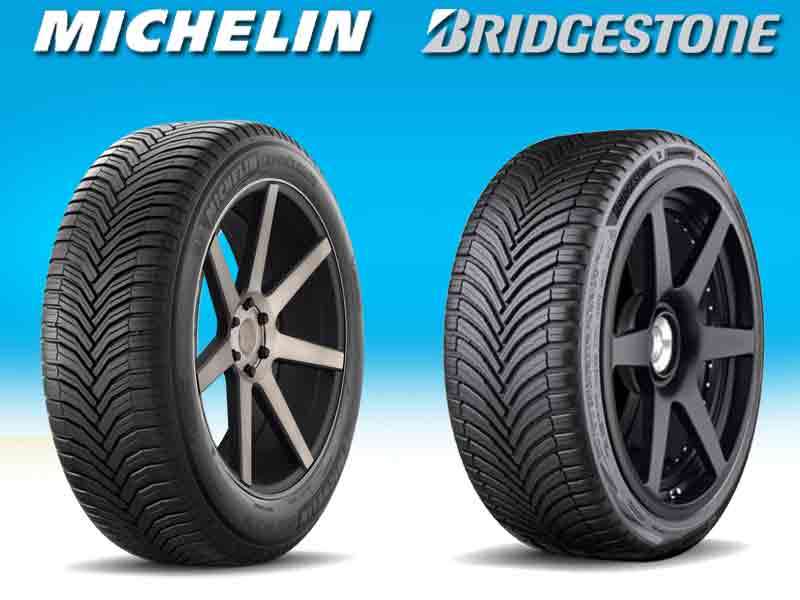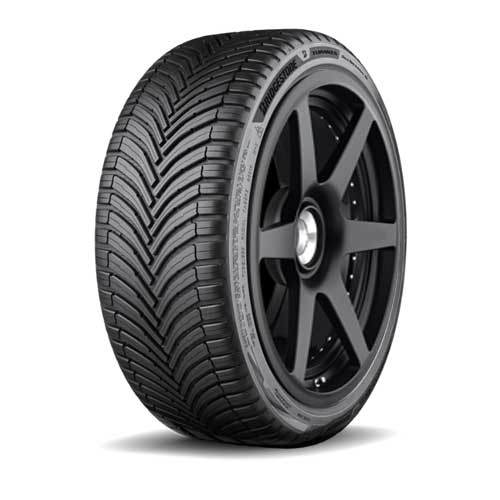Performance enthusiasts frequently ponder between the Bridgestone Turanza All Season 6 and the Michelin CrossClimate 2. Both these tires are praised for their superior handling and responsiveness. So, which one should you go for? Let’s dive into the details.
But first, let’s talk about where these tires should improve.

- Michelin CrossClimate 2 could improve in areas such as dry grip and handling, and ride comfort.
- Bridgestone Turanza All Season 6 should aim for enhancements in fuel efficiency, tread noise, and wet traction.
And so this brings us to the test scores, they achieved in our testing.
Table of Contents
Test Scores – Out of 10
| Bridgestone Turanza | Crossclimate 2 | |
| Dry Traction | 8 | 8 |
| Wet Traction | 8 | 9 |
| Snow Traction | 8 | 9 |
| Ice Traction | 7 | 9 |
| Fuel Efficiency | 8 | 8 |
| Tread Life | 7 | 7.5 |
| Ride Comfort | 7 | 7 |
Design Comparison
The Michelin CrossClimate 2 stands out from the crowd with its well engineered tread features.

Its extended arms are voided up towards the shoulders, and they get closed up, and more compacted up, as they swoop towards the middle.
These two parts of the lugs can be distinguished by the fact that they are divided up with longitudinal slits.
Here the shoulder blocks, besides being voided up have thick rectilinear sipes, while the middle blocks have both the wave like pattern and straight line siping.
Moreover, these blocks also have snow vices, as labeled on the image above.
On the other side, the Bridgestone Turanza All Season 6 features a more simplistic tread design, even though its also directional just like its counterpart.

Although the tire offers longitudinal slits, which divide up the shoulders form the central area, there’s aren’t any interlocking sipes or snow vices seen on the lugs.
Moreover, the overall siping on the lugs aren’t that thick.
But the tire is almost equally voided up compared to the its peer.
Looking at the tire, one can’t help but notice that its almost identical to the Crossclimate 2’s predecessor, the Crossclimate Plus.
Winter Performance
In winter conditions, the Michelin Crossclimate 2 performs better in comparison, with its long, sturdy arms, which help it navigate through slush and snow, in a better way.
Basically its lugs are designed to give you a better paddling of the snow, allowing the tire to have superior snow scooping abilities, even though both tires are branded with the same snow performance rating (3PMSF).
Remember, the 3PMSF rating mainly shows how well a tire can speed up in the snow, not how well it brakes or handles. A tire with this rating is about 10% better than an average all-season tire without it.
On the other side, the Bridgestone Turanza All Season 6 with its missing snow vices, and interlocking central siping can’t offer similar performance on ice and fluffy snow compared to its counterpart.
And another point, its rubber is although softer, relatively, its still not as thermally adaptive as the CrossClimate 2, (which basically stays flexible in freezing temperatures, bringing out better overall performance).
Fuel Efficiency
The way a tire interacts with the road affects its fuel efficiency, through a mix of friction and resistance.
And let me tell you that the Bridgestone Turanza All Season 6 has more rolling resistance (on average), meaning it takes more energy to keep the tire moving, and so more fuel gets consumed with this tire.
On the other hand, the Michelin CrossClimate 2 tire rolls easier on the road because of its firmer rubber design, which uses less energy.
Basically, as the tire corners, for example, its lugs aren’t that susceptible to bending, and since that molding of the tread uses up energy, it becomes a more fuel efficient option here, in comparison.
Durability and Treadwear
Rolling resistance also affects how long your tire lasts. And since the Bridgestone Turanza All Season 6 has more (rolling) resistance, it wears out faster too.
Basically with more friction with the road and its extra weight on each part of the tire cause its rubber to wear out quicker.
And yes, the tire’s softer compound isn’t fighting that wear rate either.
So overall, its understanding why you get more miles out of the Crossclimate 2.
Though keep in mind, durability wise, which has to do with internal construction, both tires are the same.
They both have a strong design with features like wide steel belts, a reinforcement layer, and belt-edge tape to resist punctures.
Wet Traction
When it’s raining, the Michelin CrossClimate 2 again does better with its special tread design and the way it’s cut.
Even though both tires offer similar hydroplaning resistance values, with their swooping arms, throwing out water away in time, the Turanza with missing siping, and biting edges, isn’t still able to clear water off at a smaller scale, (with as much efficacy).
Basically sipes suck in the water particles in their slits, and the rubber then grips on the relatively dried up surface.
That’s why the Crossclimate 2 with its wave-like middle and rectalinear shoulder siping offer superior overall wet grip in comparison.
On-Road Vibrations
The smoothness of a tire’s ride relates to its ability to absorb bumps on the road as well, and this factor depends on the tire’s construction.
The Bridgestone Turanza All Season 6 is especially good at this because it uses a softer tread rubber, which has more silica and a softer inner cap ply. These elements handle road bumps more effectively, and give you a better bumps comfort, subjectively.
On the other hand, while the Michelin CrossClimate 2 has a softer inner casing, its outer rubber layer is significantly stiffer, making the ride a bit less comfortable, in comparison.
Dry Grip And Handling
Speaking of directional grip first, the Bridgestone Turanza All Season 6 does better as it offers greater rubber to road contact relatively, simply put.
In tests, it showed 6 feet faster stopping efficacy, (directional grip is measured with braking distances).
But still when you consider the handling, you see a better response on Crossclimate 2. as this tire basically offers a narrower design (smaller section width on average), with firmer rubber on top.
Both of these features basically offer superior steering feedback, where its lugs aren’t that prone to under or over steer as much as the Turanza.
Tread Noise
Tire noise mostly comes from air interacting with the tire tread.
Air enters through gaps/shoulder voids on the sides of the tire, hits the walls inside, and the impact is what creates noise.
Here, the Michelin CrossClimate 2 does better. Even though both tires have noticeable side gaps, the Bridgestone Turanza All Season 6 has larger voids still, letting in more air. Plus, its softer rubber reflects more air, creating more, what they call, in groove resonance.
However, the difference in noise isn’t that big. This is partly due to the rounded contact patch of both tires, having directional streamlined lugs, which let most of the air out (from the other end), without making too much noise.
To Conclude
Michelin CrossClimate 2 excels in:
- Fuel Efficiency: Its firm rubber design decreases rolling resistance, helping save fuel.
- Wet Traction: Thanks to its special tread design and cut, the tire offers superior handling on wet surfaces.
- Tread Noise: Despite both tires having noticeable side gaps, the CrossClimate 2’s gaps are smaller, thus reducing air penetration and resulting in less noise.
Bridgestone Turanza All Season 6 excels in:
- Winter Performance: The tire navigates better through slush and snow due to its long, sturdy parts and cold-adaptive rubber.
- Dry Grip and Handling: It offers superior contact with the road at high speeds and shows better grip on dry surfaces.
- On-Road Vibrations: Thanks to its softer tread rubber, the Turanza 6 effectively handles road bumps, providing a smoother ride.